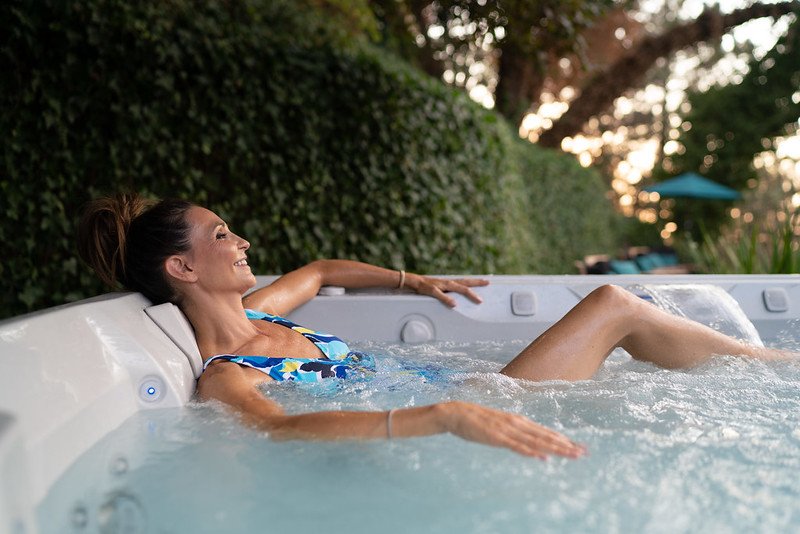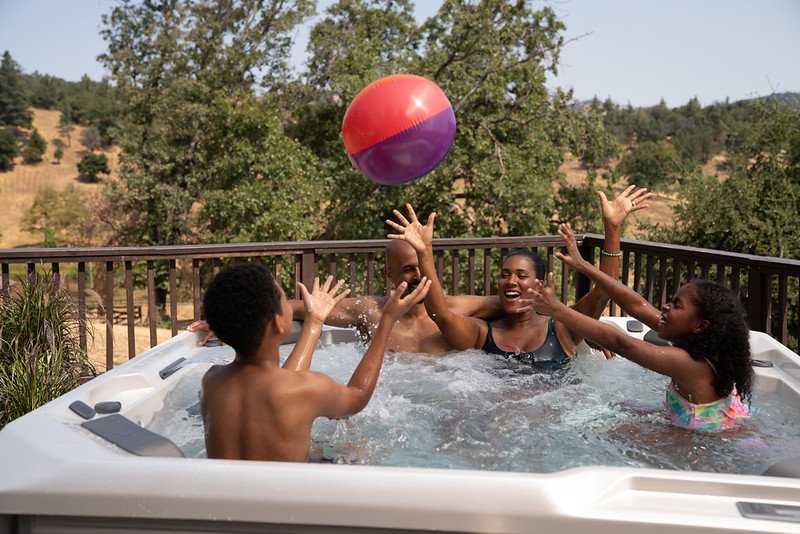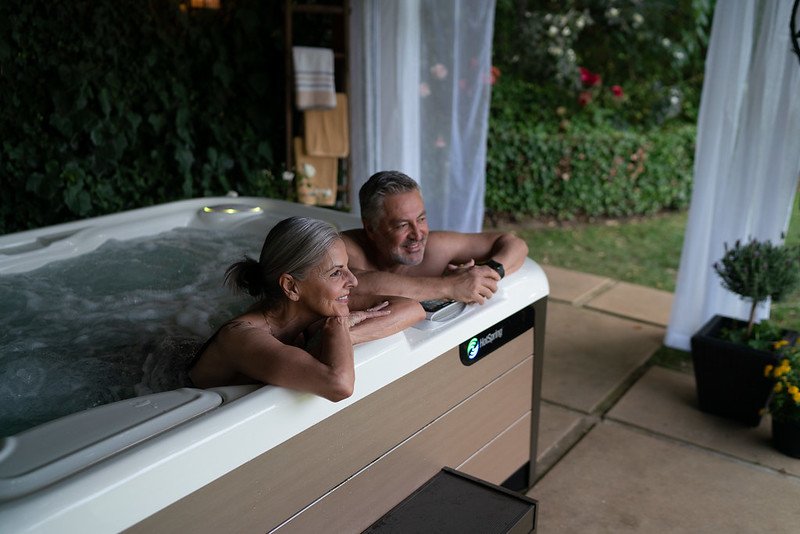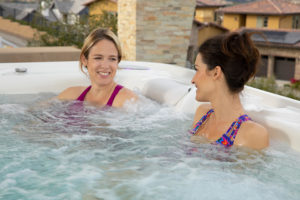
When it comes to the safe enjoyment of your hot tub, maintaining clear, sanitary water is a must. But for many first-time spa owners the task of monitoring and balancing levels of chlorine, alkalinity, pH, phosphates, and water hardness can seem daunting.
We realize the last thing you need is another complicated chore. That's why Hot Spring® Spas water care and filtration systems are designed to simplify your water care routine. Our carefully engineered Hot Spring spa filters and pumps work together to trap unwanted particles like body oils, lotions, dirt, and other environmental debris, while options like the FreshWater® Salt System and FROG® @ease® In-Line System deliver the right amount of chlorine automatically to help simplify water care. If you choose not to use a dealer installed water care system, you can opt for the traditional water care method. This takes a little more time and effort and requires manually adding chlorine and other chemicals as needed. Whatever water care system you choose, it's important that you start with well balanced water from the time you first fill your hot tub.
Test your water before filling your hot tub:
One of the most important things you can do to ensure the success of your water care routine takes place before you put a drop of water into your hot tub. You've probably noticed that tap water can taste and even look different depending on where it comes from. In some areas, you might enjoy drinking a glass of water right from the tap, but in others you wouldn't dream of drinking or cooking with unfiltered water. In addition, well water in rural areas might be high in metal or other minerals and require extra treatment.
To adjust for the quality of your water, be sure to test it before filling your hot tub. Take a sample of your fill water (the water that comes out of your hose) to your local dealer so they can determine if it contains high levels of metals, phosphates, and/or calcium. If high levels are detected, your dealer can recommend additional products to help bring your fill water into balance.
Are you using well water or have high metal content in your water? If so, this step is extra important! Iron and manganese should be below 0.5 parts per million (ppm) and copper should be below 0.2 ppm. If metals are present in the water, they can be filtered out during the fill process using the FreshWater Clean Screen® Pre-Filter. FreshWater Stain and Scale Defense can also be used at this time.
During set up, it's also important to test for phosphates in your fill water using FreshWater Phosphate Test Strips. Phosphates can be present in city and municipal water sources and contribute to algae growth which will reduce the effectiveness of your salt system.
Once your spa is up and running, use test strips regularly to check your levels of alkalinity, pH, calcium or water hardness, phosphates and chlorine.
Color-coded test strips can be purchased from your local hot tub dealer. There are different test strips available, depending on your water care system.
Your Hot Spring Spas dealer can help you choose the appropriate strip from these options:
- FreshWater 5-Way Test strips for Bromine, Chlorine, pH, Alkalinity and Calcium Hardness
- FreshWater Salt Test strips for salt levels (applicable only for FreshWater Salt System)
- FreshWater MPS Test Strips for MPS, alkalinity and pH
- FreshWater Phosphate Test Strips for phosphate levels
- Frog @ease SmartChlor Test Strips must be used with Frog @ease water care option
When you dip a test strip in your spa water, you will see if the alkalinity, pH, calcium or water hardness, chlorine levels, and overall condition of the water is within acceptable levels (see test strip packaging for instructions).
If you're a visual learner, check out this short video that describes testing your water's chemical levels.

Testing and Adjusting Alkalinity:
With your test strip in hand, you'll first test the water's alkalinity. Alkalinity is a measurement of how well your water neutralizes acid. The higher the alkalinity, the more acid it will take to lower your water's pH. The pH of spa water is important because chlorine works best at eliminating bacteria at a certain pH level (more on this below). Be sure your spa water is warm when you test it.
Dip your test strip into the water and compare the color of the strip to the color on the product packaging to interpret the reading. Consulting your packaging is especially important if your test strip measures multiple water conditions at once. The color of your test strip will let you know if the alkalinity level is too low, too high, or just right.
The alkalinity level should be between 80 and 120 parts per million ppm. If it's not in that range, you'll have to adjust it. Sodium bicarbonate will raise the alkalinity level; sodium bisulfate will lower it. These products, packaged by various manufacturers, are sold under names including “spa up” and “spa down” and “alkalinity up” and alkalinity down.” You should always use the product recommended by your spa's manufacturer. If you're unsure, consult your local dealer - they'll be happy to help!
Testing and Adjusting pH level:
After testing and adjusting alkalinity levels, use the same test strip to check the pH level of your spa water. pH describes how acidic or “basic” your water is on a scale from 0 to 14, with 7 being neutral. Numbers below 7 describe acidic substances, while numbers above 7 describe basic substances. Chlorine destroys bacteria best when the pH level is between 7.2 and 7.8, which is slightly more basic than true neutral.
If your pH level is outside the acceptable range—and you're sure your alkalinity levels are correct—use the pH up or pH down product that your manufacturer and dealer recommend to coax it back to the right level.
While various products may work to adjust your pH, it's always best to use products manufactured by or at least approved by your hot tub's manufacturer. Always check with your local dealer before using any product in your hot tub.

New technology in water care makes maintenance easier, allowing more time for you to enjoy your spa.
Testing and Adjusting Water Hardness:
After you've tested and adjusted your spa water's alkalinity and pH levels, the next step is to check your water's hardness. Hardness refers specifically to the amount of calcium and magnesium in the water
.Water hardness results directly from the mineral content of your water source. That means, if your tap water comes from a municipal well with high levels of natural calcium, you'll likely have hard water in your hot tub. Hardness will not change much as you soak over time; it will only go up or down when you add or remove water or add or remove calcium.
The ideal amount of calcium and magnesium in your water is between 175 and 275 ppm. If you have too much of either, your water will not hold chlorine effectively. Scale may begin to grow on the spa shell and in its plumbing, and your water may be cloudy. Products such as Vanishing Act® and the FreshWater Clean Screen® Pre-Filter can lower calcium levels.
If you have too little calcium, the shell, plumbing, and jets may all experience corrosion from the soft water. Fortunately, the remedy for this is simple: add calcium. Your local dealer will show you approved calcium products to use in your hot tub, which will likely include the following:
- Vanishing Act
- Vanishing Act XL
- On The Go portable water softener
Testing and Adjusting Phosphate Levels:
Phosphates are salts made up of phosphorus and oxygen and can be combined with a variety of minerals, molecules, or compounds. Even if they are not present when the spa is filled, these phosphates build up over time in spa water and can increase chlorine demand by accelerating the growth rate and quantity of algae and bacteria.
The acceptable range for phosphates is 0 - 300 ppb (parts per billion): Phosphate ppb levels above 300 ppb can lead to damage of the salt cartridge by coating the electrodes with calcium phosphate scale, which is difficult to remove. That's why it's important to test water using FreshWater Phosphate Test Strips on a monthly basis — especially when there are problems with maintaining chlorine levels, or if the spa water changes color. Treat the spa water when phosphate levels exceed 300 ppb and continue to test on a regular basis Phosphate removal products can be purchased from your local Hot Spring Spas dealer. These products are easy to administer and will strip phosphates from the water, producing a solid that can be filtered out.
Shocking Your Hot Tub:
To make sure nothing overwhelms your base layer of chlorine, it's a good idea to “shock” your spa once a week and after it's been used by many people at once. Shocking your spa means giving it a large dose of chlorine to break down any buildup of contaminants that can cause an odor or cloudy water. Your dealer can direct you to manufacturer-approved spa shock products.
A Simple Water Care Routine Will Keep Spa Water Fresh and Sanitary:
Keeping your new hot tub in pristine condition comes down to testing your water regularly and adjusting it as necessary. Just a few minutes each week is all it will take to enjoy the benefits of your spa whenever the mood hits you. Test strips and adjustment products are available as kits from your local dealer, who is also always on hand to answer any questions you have about your spa.
At Hot Spring®, we believe that the time you spend in your spa should be the best part of your day. That's why we work hard to simplify the hot tub water maintenance process, whether you choose the Freshwater Salt System, FROG® @ease® In-Line Sanitizing System, or another water care option. To inquire about hot tub pricing, you can request a quote here.
